E1.1 Identify geometric properties of rectangles, including the number of right angles, parallel and perpendicular sides, and lines of symmetry.
Skill: Determining the Number of Right Angles in a Rectangle
Students begin to explore that angles are formed by two intersecting line segments. The angle between two intersecting line segments can be described as the tilt of one of the line segments relative to the other, at their point of intersection.
Source: translated from Guide d'enseignement efficace des mathématiques de la 4e à la 6e année, Géométrie et sens de l'espace, Fascicule 1, p. 22.
A right angle measures 90° and is formed by two lines that are perpendicular to each other. Students should be able to determine the number of right angles in a rectangle by exploring the rotation of one of the right angles in the rectangle. The rotation demonstrates each intersection of two perpendicular sides of the rectangle.
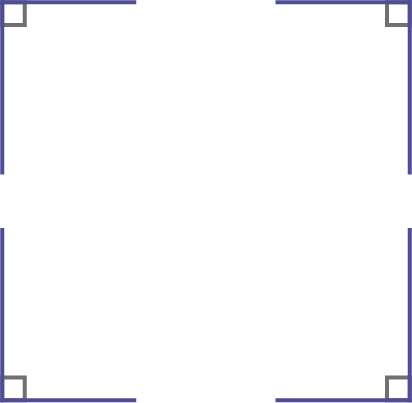
Students should be able to identify four right angles in a rectangle.
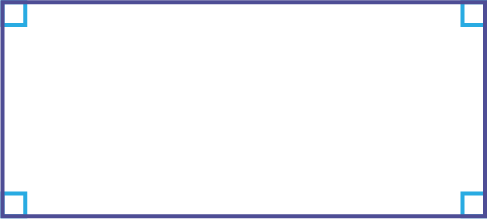
Skill: Determining the Number of Parallel Sides in a Rectangle
A right angle measures 90° and is formed by two lines that are perpendicular to each other. Students should be able to determine the number of right angles in a rectangle by exploring the rotation of one of the right angles in the rectangle. The rotation demonstrates each intersection of two perpendicular sides of the rectangle.
Students should be able to identify two pairs of parallel opposite sides.
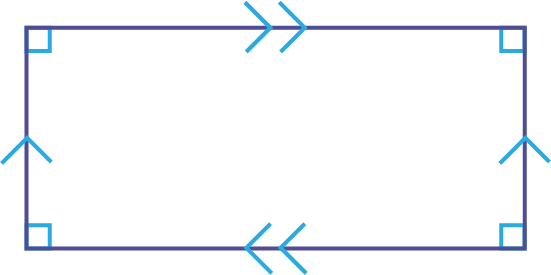 image A quadrilateral formed by two sets of parallel segments that intersect. The corners are marked by small squares.The shorter congruent parallel segments are identified by a single arrow each, while the longer congruent parallels are identified by two arrows each.
image A quadrilateral formed by two sets of parallel segments that intersect. The corners are marked by small squares.The shorter congruent parallel segments are identified by a single arrow each, while the longer congruent parallels are identified by two arrows each.
Skill: Determining the Number of Perpendicular Sides in a Rectangle
Students should be able to determine the number of perpendicular sides in a rectangle by counting the sides that meet or intersect at right angles. Since perpendicular sides form a 90° right angle, the number of right angles can also indicate the number of perpendicular sides. These counts will be identical.
Students should be able to identify four pairs of perpendicular sides or four right angles.

Skill: Determining the Number of Lines of Symmetry in a Rectangle
Rectangles have 90º right angles that allow for the formation of two lines of symmetry. Students should be able to reveal the lines of symmetry by folding a rectangle on a line of symmetry to create identical shapes. Determining the number of lines of symmetry can also be done by creating two identical shapes using a Mira.
Students should be able to identify two lines of symmetry in a rectangle.

Knowledge: Rectangle
A geometric shape of the trapezoid and parallelogram family, which has the following geometric properties:
- two pairs of congruent sides;
- four right angles (90°);
- two pairs of parallel opposite sides;
- two diagonals that intersect in the middle;
- two lines of symmetry.
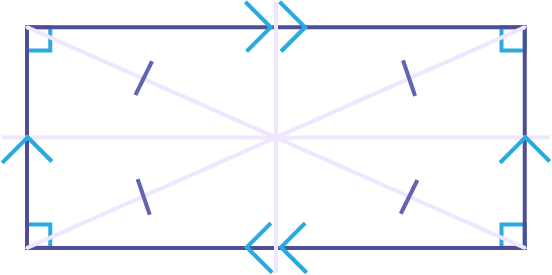 image A quadrilateral formed by two sets of intersecting parallel segments. The shorter congruent parallel segments are identified by a single arrow each, while the longer congruent parallels are identified by two arrows each. The shape is divided into 8 triangles by two sets of diagonals marked by a small line and a vertical and horizontal line.
image A quadrilateral formed by two sets of intersecting parallel segments. The shorter congruent parallel segments are identified by a single arrow each, while the longer congruent parallels are identified by two arrows each. The shape is divided into 8 triangles by two sets of diagonals marked by a small line and a vertical and horizontal line.
Source: translated from Guide d'enseignement efficace des mathématiques de la 4e à la 6e année, Géométrie et sens de l'espace, Document d'appui, Fascicule 1, p. 36.
Knowledge: Right Angle
A right angle is formed from the intersection of two perpendicular lines. Angles are classified according to degrees of rotation, since they are essentially the measure of a rotation about a point.
A right angle is an angle that measures exactly 90°. The Grade 4 student does not need to know the measurement of 90°, this concept will be formally introduced in Grade 5.
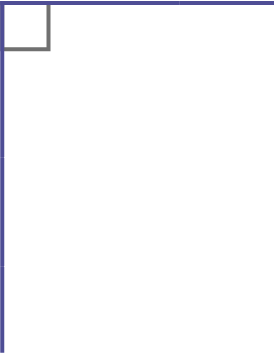
Source: translated from Guide d'enseignement efficace des mathématiques de la 4e à la 6e année, Géométrie et sens de l'espace, Document d'appui, Fascicule 1, p. 16.
Knowledge: Parallel Sides
Parallel sides of a rectangle are sides of a two-dimensional shape whose distance between them remains constant. Parallel sides of a rectangle are opposite sides. To represent a pair of parallel sides on a rectangle, identical arrows are placed on opposite sides. A second pair of parallel sides is represented by two arrows, and so on.
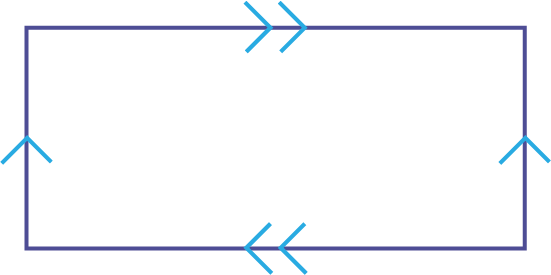 image A quadrilateral formed by two sets of parallel segments that intersect. The corners are marked by small squares. The shorter congruent parallel segments are identified by a single arrow each, while the longer congruent parallels are identified by two arrows each.
image A quadrilateral formed by two sets of parallel segments that intersect. The corners are marked by small squares. The shorter congruent parallel segments are identified by a single arrow each, while the longer congruent parallels are identified by two arrows each.
Knowledge: Perpendicular Sides
Two perpendicular sides are sides of a rectangle that meet or intersect at right angles. To indicate two perpendicular sides, a right angle is drawn using a small square placed at the intersection of the two sides.
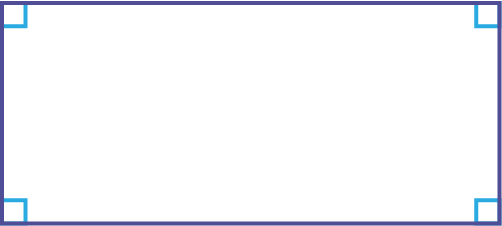
Knowledge: Lines of Symmetry
A rectangle has four lines of symmetry.
